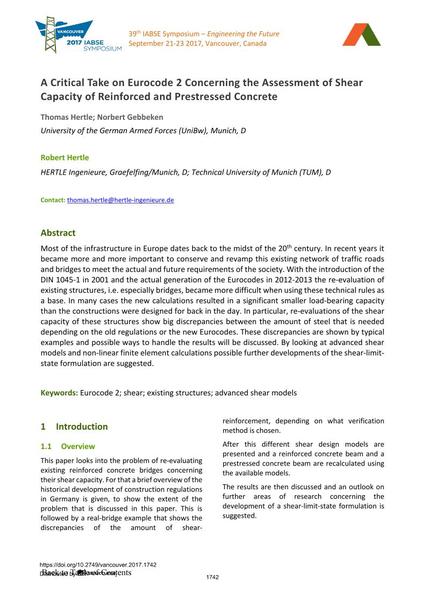A Critical Take on Eurocode 2 Concerning the Assessment of Shear Capacity of Reinforced and Prestressed Concrete

|
|
|||||||||||
Détails bibliographiques
| Auteur(s): |
Thomas Hertle
(University of the German Armed Forces (UniBw), Munich, D)
Norbert Gebbeken (University of the German Armed Forces (UniBw), Munich, D) Robert Hertle (University of the German Armed Forces (UniBw), Munich, D) |
||||
|---|---|---|---|---|---|
| Médium: | papier de conférence | ||||
| Langue(s): | anglais | ||||
| Conférence: | IABSE Symposium: Engineering the Future, Vancouver, Canada, 21-23 September 2017 | ||||
| Publié dans: | IABSE Symposium Vancouver 2017 | ||||
|
|||||
| Page(s): | 1742-1749 | ||||
| Nombre total de pages (du PDF): | 8 | ||||
| Année: | 2017 | ||||
| DOI: | 10.2749/vancouver.2017.1742 | ||||
| Abstrait: |
Most of the infrastructure in Europe dates back to the midst of the 20th century. In recent years it became more and more important to conserve and revamp this existing network of traffic roads and bridges to meet the actual and future requirements of the society. With the introduction of the DIN 1045-1 in 2001 and the actual generation of the Eurocodes in 2012-2013 the re-evaluation of existing structures, i.e. especially bridges, became more difficult when using these technical rules as a base. In many cases the new calculations resulted in a significant smaller load-bearing capacity than the constructions were designed for back in the day. In particular, re-evaluations of the shear capacity of these structures show big discrepancies between the amount of steel that is needed depending on the old regulations or the new Eurocodes. These discrepancies are shown by typical examples and possible ways to handle the results will be discussed. By looking at advanced shear models and non-linear finite element calculations possible further developments of the shear-limit- state formulation are suggested. |
||||
| Mots-clé: |
structures existantes Eurocode 2
|
||||
